I didn’t have much of a plan when I went to London, I had lots of vague ideas about different places I’d like to visit, but nothing set in stone and I found myself changing my plans on a whim during the trip.
One of the places I’d thought about visiting was St Paul’s Cathedral. I’d visited St Paul’s some 10 years earlier and when I lived in London, I was a regular visitor to the café in its crypt. So I was keen to revisit one of the capital’s most iconic landmarks.

After spying St Paul’s through a window at the Tate Modern (above), I decided to make it my next port of call and on leaving the museum, crossed the Millennium Bridge over the Thames.
It was late afternoon and the golden hour was in full swing, bathing St Paul’s and the Thames in the warm amber hue of the setting sun. It was an awesome sight.
It was almost 3.30pm when I arrived at St Paul’s and the sales assistant was worried I wouldn’t have enough time to see everything before the cathedral closed for the day, so she suggested I turn my ticket into an annual ticket for free.
This meant if I ran out of time, I could come back the next day and finish touring the cathedral.
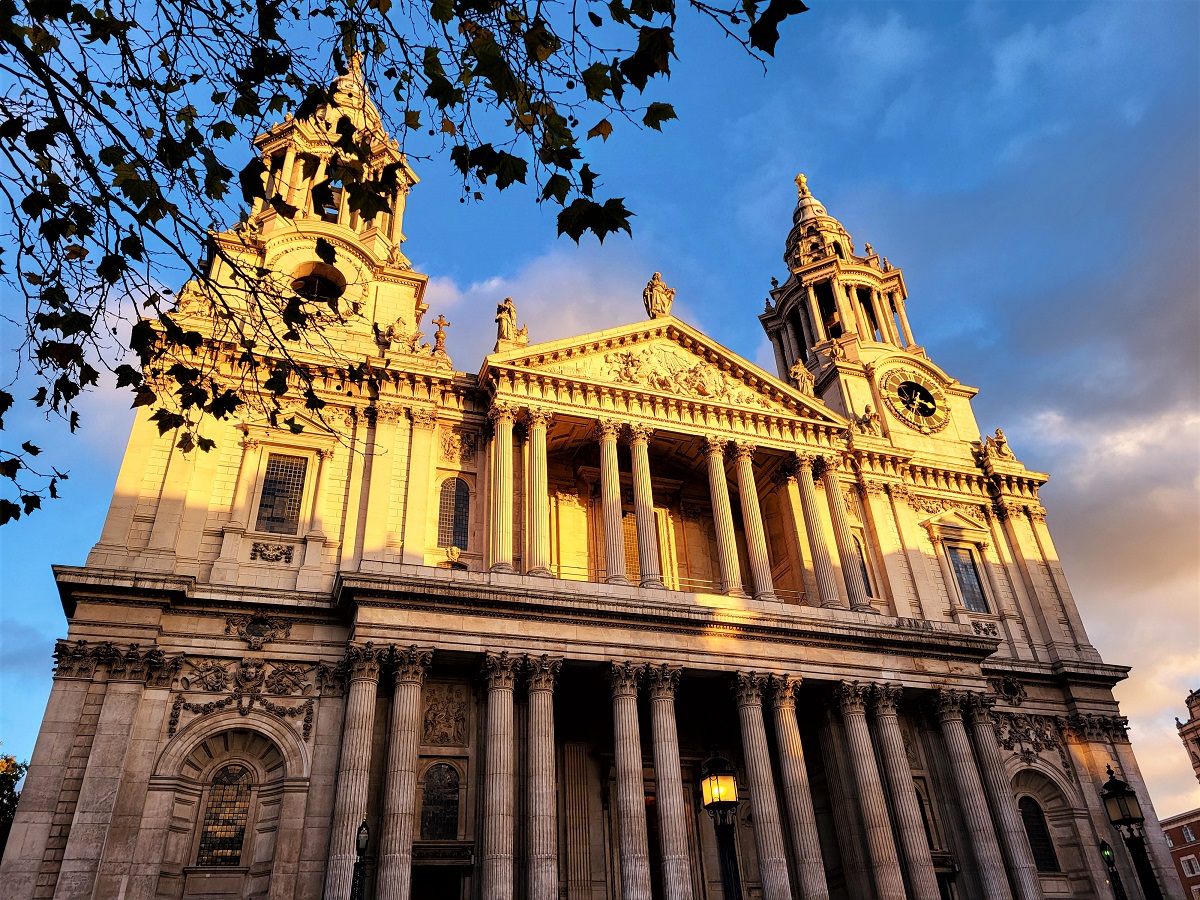
There’s been a church of some sort on the site since 604 when Bishop Mellitus founded the original St Paul’s Church and the present cathedral is the fifth incarnation.
Sir Christopher Wren’s iconic masterpiece was built to replace the old St Paul’s Cathedral, which burned down in the Great Fire of London in 1666.
It seems unthinkable now as St Paul’s is such an integral part of the London skyline, but back in the 1670s, Wren’s design was thought to be too radical and he had to change it slightly to appease those who wanted a more traditional style (think Westminster Abbey or Gloucester Cathedral).
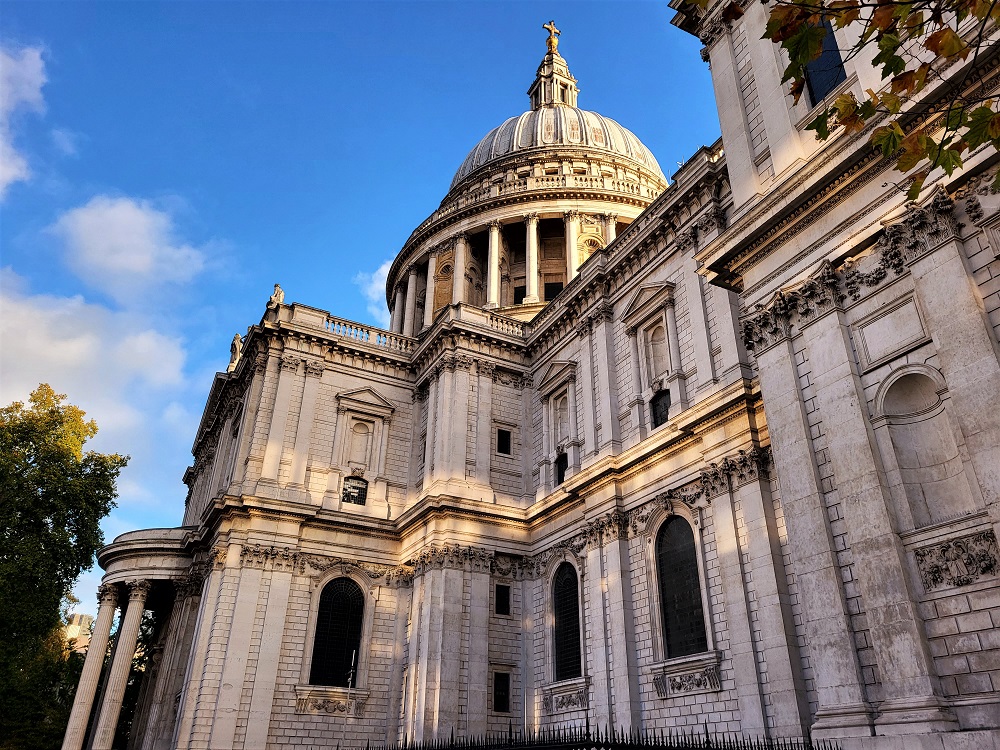
Over the centuries the cathedral has played host to a slew of high profile events including the lying in state of King Henry V (he of the Battle of Agincourt fame), and the doomed royal weddings of Katherine of Aragon to her first husband Prince Arthur (Henry VIII’s elder brother) and more recently that of Prince Charles and Lady Diana Spencer.
Four of the Gunpowder Plotters were also executed in St Paul’s churchyard in January 1606.
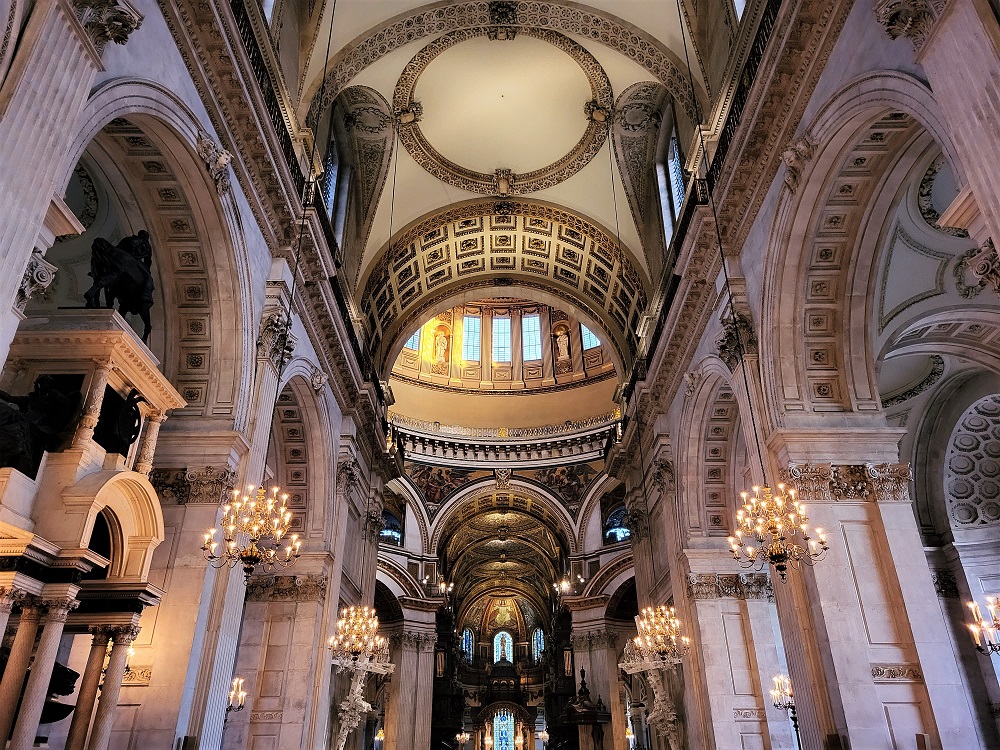
As I stepped inside the cathedral’s nave (above), I was taken aback by just how splendid the Baroque interior is – it’s utterly breathtaking and rivals the great Italian cathedrals.
Although I’d been to St Paul’s before, I’d forgotten just how ornate and detailed the decoration is and found myself walking around in awe at the spectacular sight before me.
The focal point of St Paul’s is the enormous dome (above). It’s one of the world’s biggest cathedral domes, measuring 111m high and weighing a whopping 65,000 tons. Words can’t describe just how utterly stunning it is.
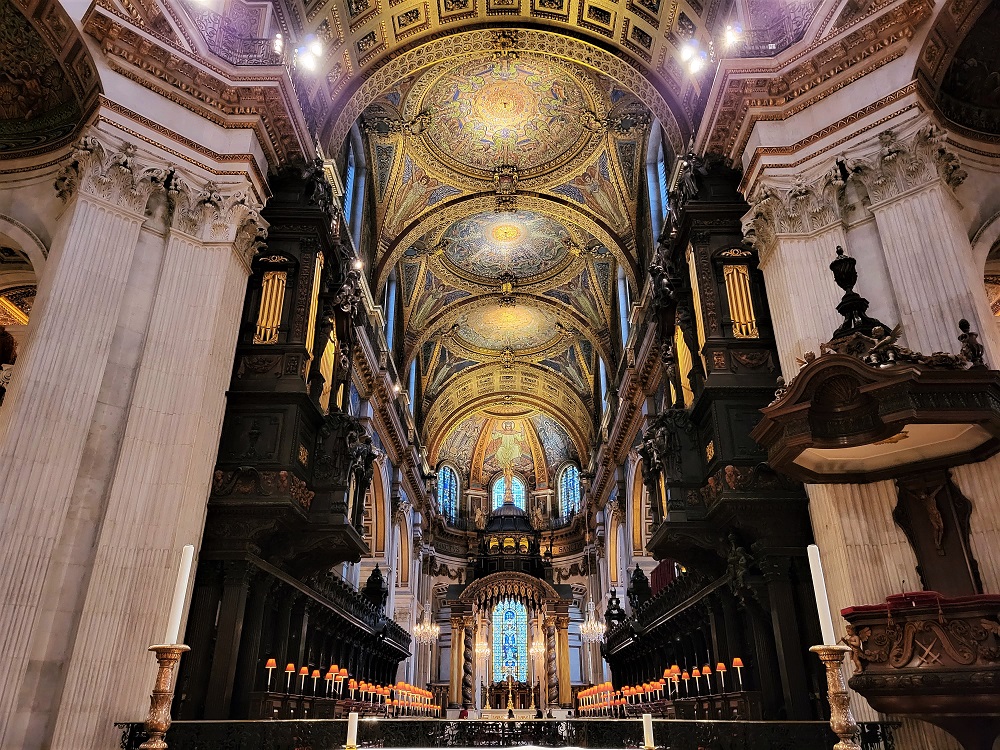
Not to be outdone is the equally jaw-dropping quire, which lies just beyond the dome, and the striking high altar (above).

To the right and left of the dome are the north and south transepts (above and below).
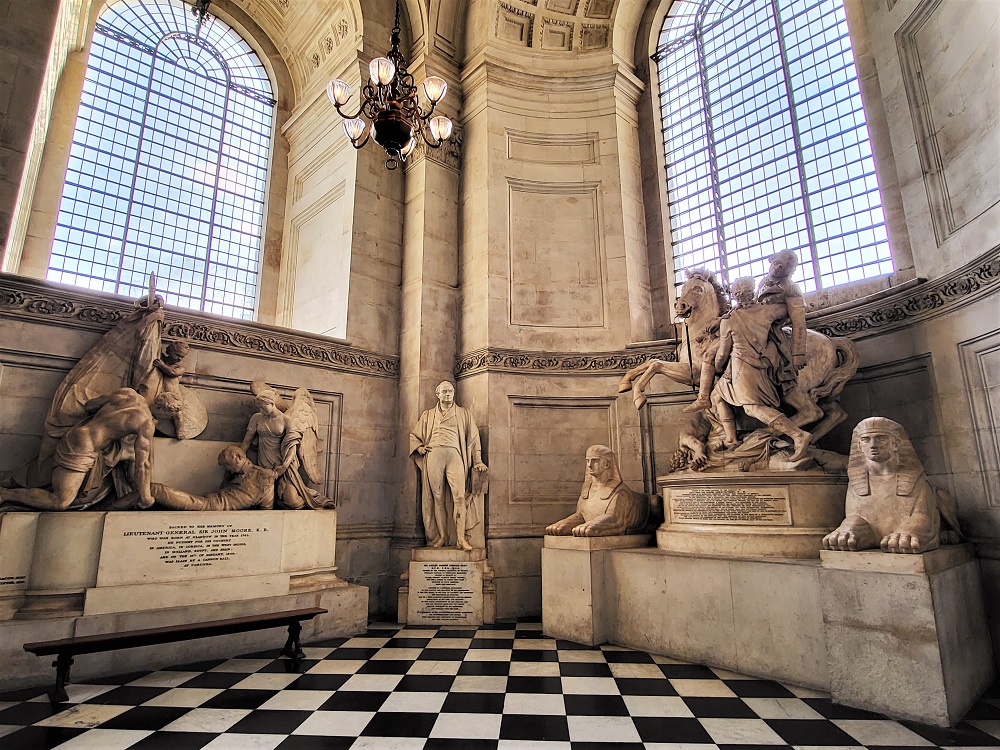
Wren’s original plans for the cathedral didn’t include any statues, but today statues commemorating famous figures adorn the cathedral, including these in the south transept.
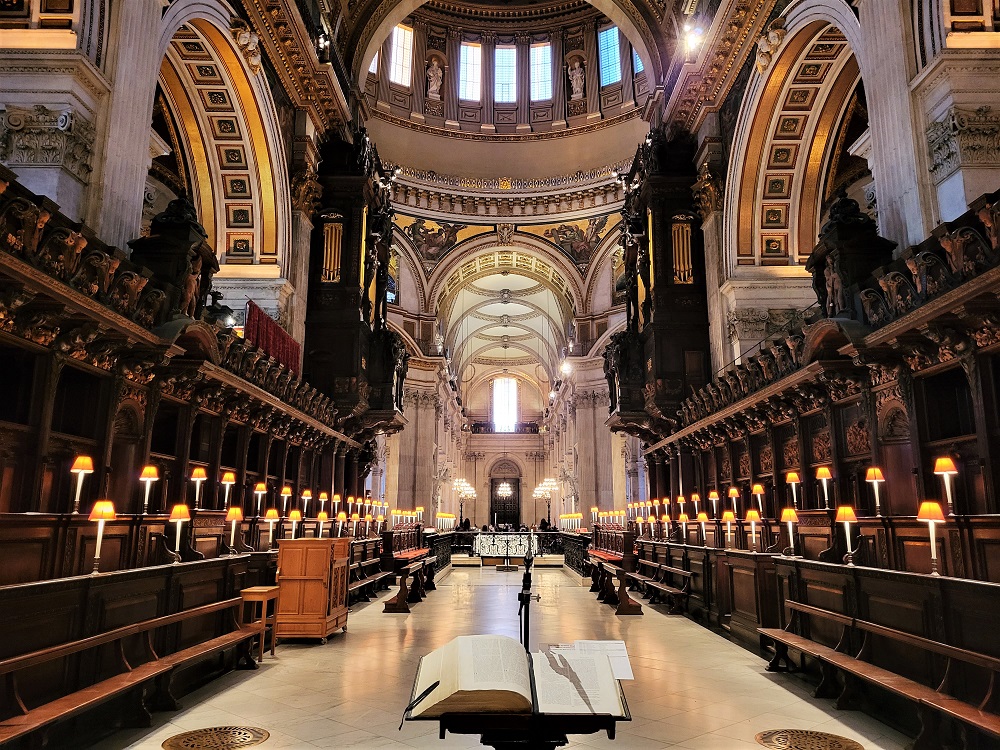
I continued my tour of the cathedral by strolling down the south quire aisle, turning to my left to take a closer look at the quire (above) and the high altar (below).

One of the many marvellous features inside St Paul’s Cathedral is the Byzantine-like mosaic ceilings that adorn the quire and the apse (below).

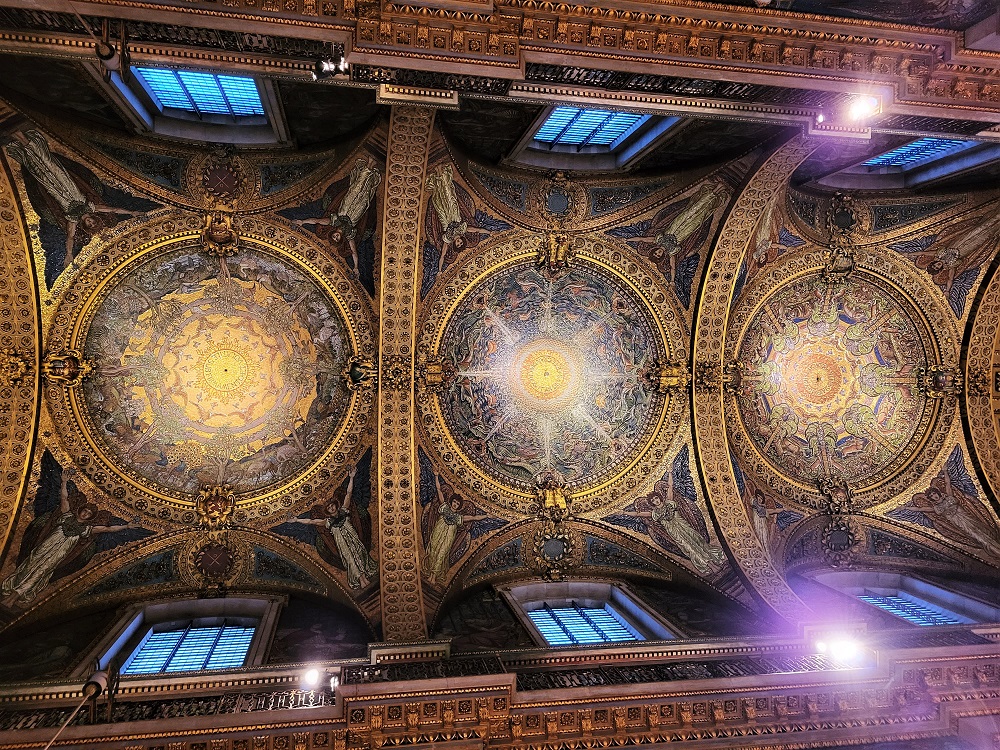
The mosaics were added in the late 19th century by the artist William Blake Richmond in recognition of St Paul’s Catholic heritage and they commemorate various scenes and figures from the Bible, including the creation and the crucifixion.
They’re astonishing and completely different to anything I can recall seeing in any other British cathedral. They reminded me a lot of the mosaics in the Basilica di San Marco in Venice.
By now I’d seen everything there was to see on the ground floor of the cathedral, so I walked back to the south transept to make my way to the stone and golden galleries.
St Paul’s has three viewing galleries – the whispering gallery, which looks down into the cathedral and is currently closed to visitors; the stone gallery, at the base of the dome, which offers superb views of London; and the golden gallery at the top of the dome, which boasts even better views of the capital.

The first parts of the journey to the stone gallery are easy because the staircases are reasonably wide and gradual. There are also lots of stone benches, where you can sit and take a breather if you want one.
But at the top of the second staircase, you have to go through a short passageway (above) to reach the last part of the climb and this is where things get a little more nervewracking.
I’m used to climbing rickety, winding staircases in castles and other old buildings, but I really don’t like going up the narrow, metal staircases to the stone and golden galleries.
I’ve done the climb twice and both times I’ve felt anxious and experienced a touch of vertigo, even though there are plenty of safety measures in place.
Children under 18 who attempt the climb must be accompanied by an adult at all times and I’d suggest not attempting it at all if you’re scared of heights as I’m only very mildly scared of heights and it freaks me out.
Despite the jitters and the sweaty palms, I like having the chance to go ‘behind the scenes’ of the cathedral because the plain passageways and staircases are in complete contrast to the splendour of the main body of St Paul’s.

After making sure I looked anywhere but down during the final part of the climb, I arrived at the stone gallery (above).

The climb may have been unnerving, but I soon forgot about it as I soaked up the incredible views over the capital (above and below).

By now it was after 4pm and the light was starting to fade, which made the views even more beautiful.
Having marvelled at the views from the stone gallery, I made my way to the golden gallery via another set of anxiety-inducing staircases.

The golden gallery is much narrower than the stone gallery, so it was a little trickier manoeuvering around it and the other visitors.
But being higher up, the views are even better than those from the stone gallery and they made the awful climb worth it.

Having admired the views from the golden gallery in every direction, I gingerly made my way back down to the main body of the cathedral, where I found everything was winding down in preparation for the Choral Evensong at 5pm.
It was too late to visit the crypt, so I resolved to make use of my annual ticket and returned to St Paul’s the following afternoon to see the remaining part of the cathedral.

The extensive crypt beneath St Paul’s is, according to the cathedral’s website, “the largest in Europe”, and it’s the resting place for many a notable Briton.

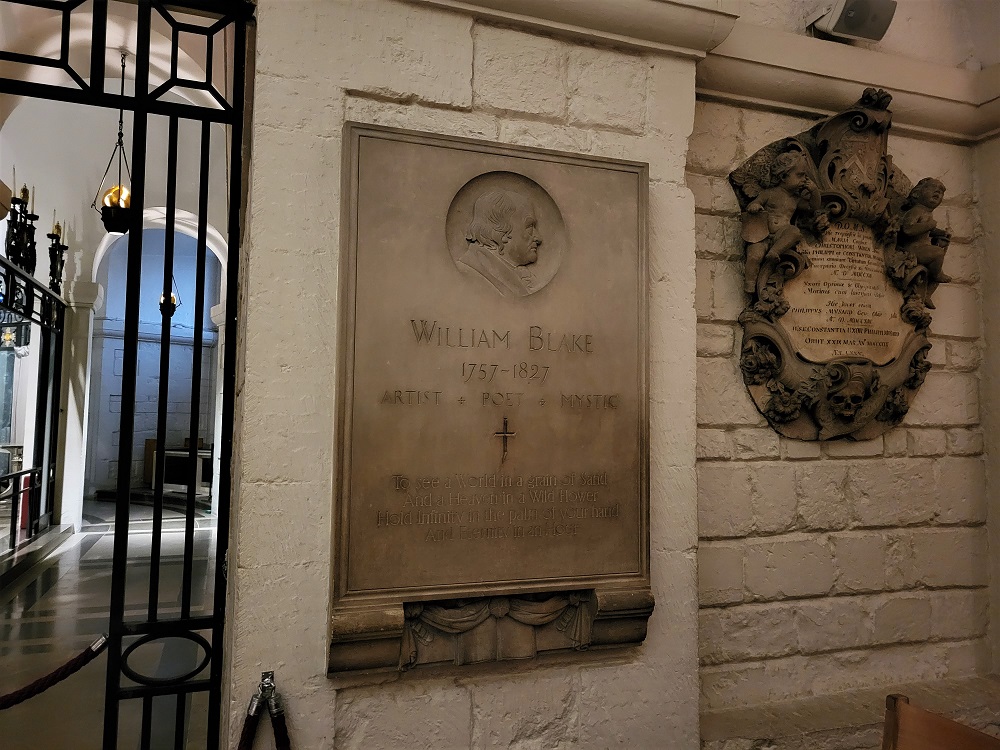
Among the famous Brits buried beneath its vaulted ceilings are Florence Nightingale, William Blake, the painters Sir Joshua Reynolds, Sir John Everett Millais and JMW Turner, the godfather of pencillin Sir Alexander Fleming and the scientist Robert Hooke.
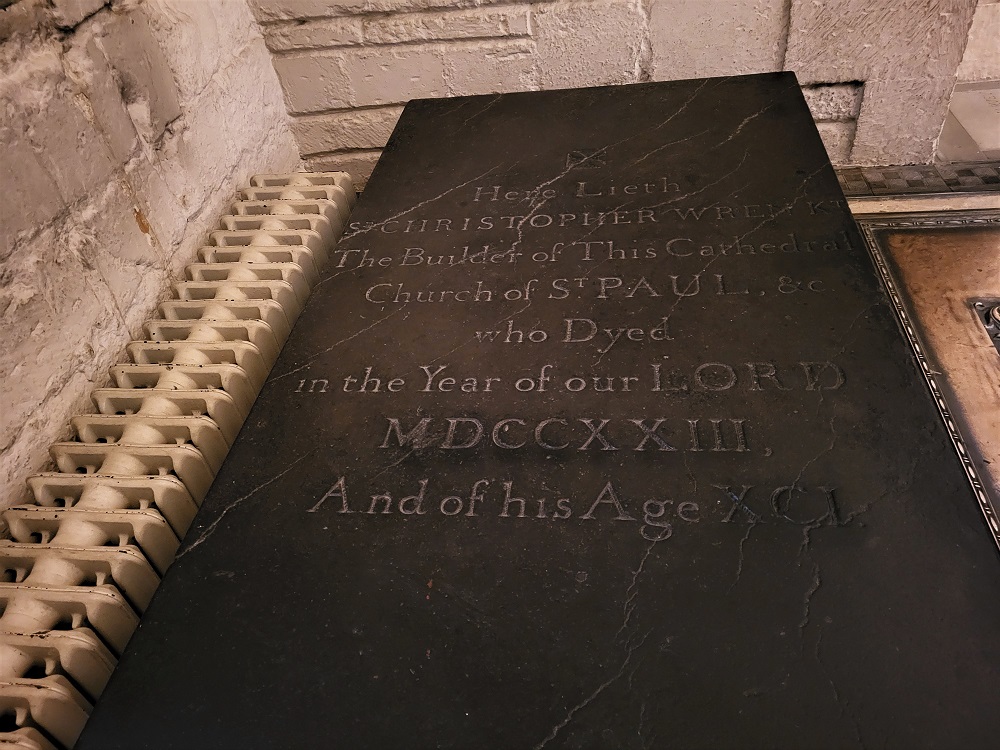
The cathedral’s architect, Sir Christopher Wren, is also buried in a corner of the crypt in a rather unremarkable tomb (above).
The most ostentatious tomb in the crypt belongs to Horatio Nelson (below), the legendary admiral killed at the Battle of Trafalgar in 1805.
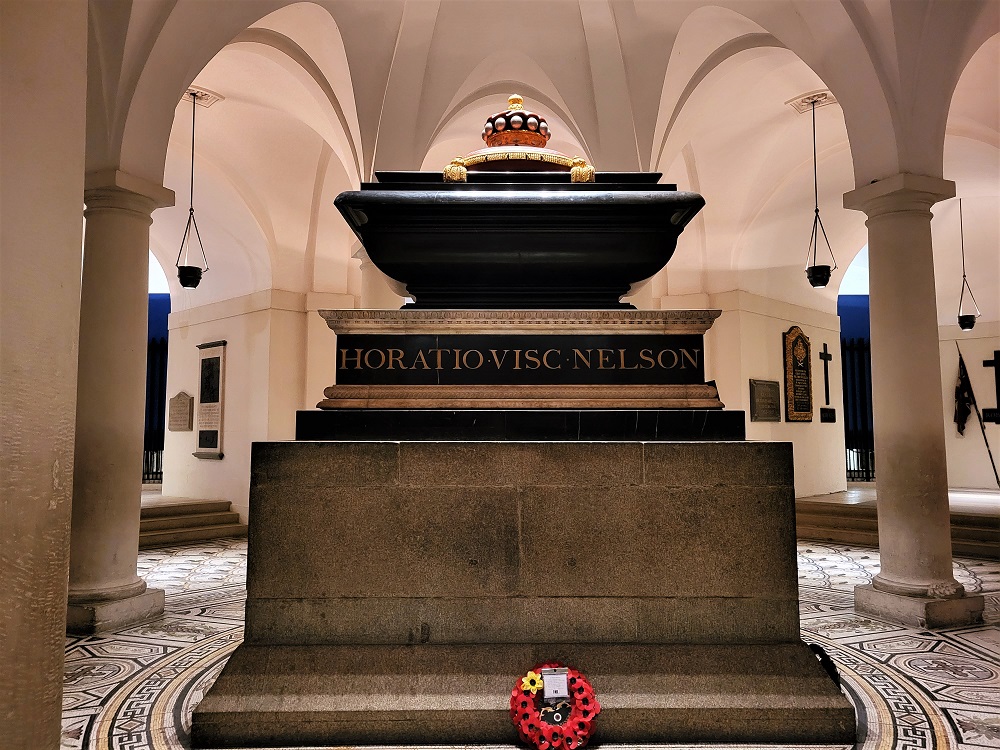
Nelson had wanted to be buried at Westminster Abbey, but the abbey was full by the time he died, so he was laid to rest in St Paul’s instead.
He’s one of only three people who’ve had the honour of a state funeral at St Paul’s. The other two being Arthur Wellesley, the 1st Duke of Wellington, renowned for the Battle of Waterloo, and the wartime Prime Minister Sir Winston Churchill.
While Wellington is also buried in St Paul’s, Churchill was laid to rest in the churchyard at Bladon in Oxfordshire, near his birthplace Blenheim Palace.
I really enjoyed my visit to St Paul’s Cathedral. I’d forgotten just how spectacular and grand the cathedral is. It really is one of the world’s great cathedrals.
When I visit London, I often go to see exhibitions or some of the smaller, less well-known attractions, overlooking the more famous sights such as St Paul’s because I’ve been to them all before.
But my visit reminded me just how remarkable some of these monuments are and I’ve resolved to make more of an effort in the future to see them, too.
Info
St Paul’s Cathedral, St Paul’s Courtyard, London EC4M 8AD
Open 8.30am to 4pm on Mondays, Tuesdays, Thursdays, Fridays and Saturdays, and from 10am to 4pm on Wednesdays
stpauls.co.uk


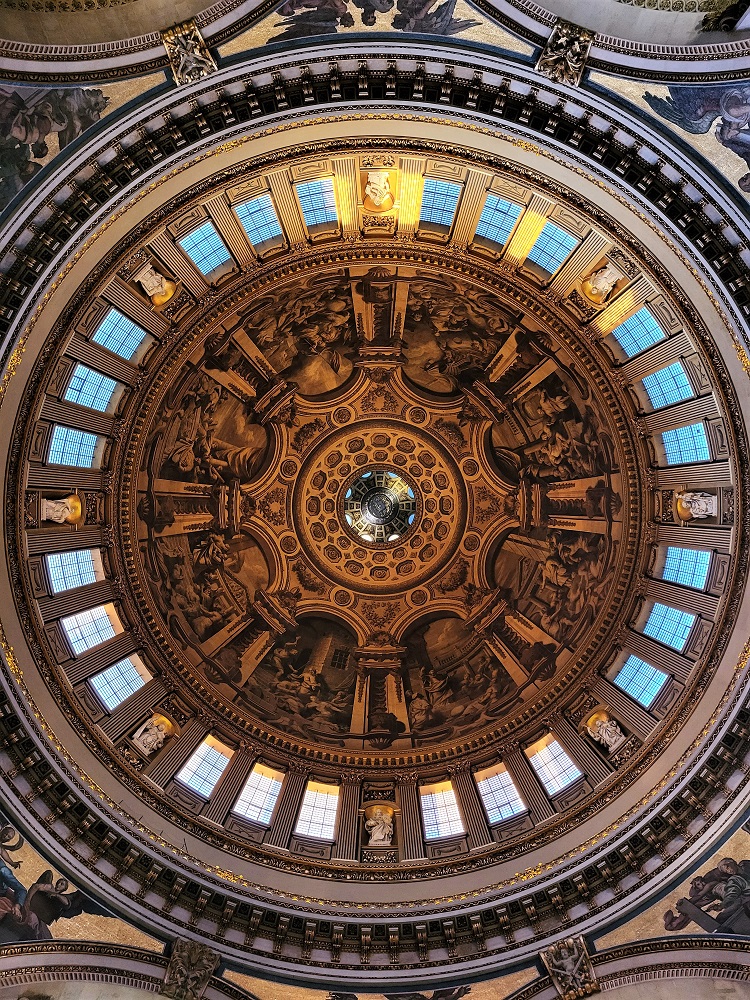
Beautiful photos – the golden gallery was closed when I visited to glad to see what the views would have been 🙂
LikeLiked by 1 person
Thanks Hannah 🙂
LikeLike
Your photographs are stunning. I think the last time i actually went inside St Paul’s was over 40 years ago. I really should go back!
LikeLiked by 1 person
Thanks Annabel! I’d forgotten just how stunning the cathedral is. It’s definitely worth going back
LikeLiked by 1 person
St Paul’s Cathedral looks beautiful, especially in the golden glow of the afternoon sun. The interior is even more stunning. It looks like you had the place all to yourself. And what a great view overlooking the city. Thanks for sharing. Linda
LikeLiked by 1 person
Thanks Linda! It’s a stunningly beautiful building and the views overlooking the city are just superb.
LikeLiked by 1 person
This cathedral is beautiful 😍. Gorgeous photos.
LikeLiked by 1 person
Thanks Mélodie, it’s a spectacularly beautiful building 🙂
LikeLike
Wow, what a truly fascinating and historical building, especially its beautiful dome. I’ve been to London many many times, but somehow never made the time to step inside Saint Paul’s Cathedral and now, after seeing your photos, I have to definitely do it next time I’m in the city. Thanks for sharing and have a good day 🙂 Aiva xx
LikeLiked by 1 person
It’s a beautiful building and well worth a visit if you’ve never been before. There’s lots to see and the architecture’s superb. Thanks for taking the time to comment! Have a good day, too 🙂 Bethan xx
LikeLiked by 1 person
You have documented this site beautifully in both words and images. Did you have to be patient to get all those shots free of people? It looks like you were wandering around by yourself! I was born in London and have never been inside St. Paul’s, something I definitely have to put right one of these years. Such dramatic views of the London skyline, especially with those almost apocalyptic clouds, it actually makes me miss the old joint, ha ha. Christopher Wren was a genius, I would also have expected a more lavish tomb.
LikeLiked by 1 person
Thanks, that’s very kind of you. I definitely wasn’t alone in the cathedral! I sometimes have to be a little patient to get the shots, but I usually only have to wait a minute or two. I also like to play around with the camera angles, so it sometimes looks emptier than it is. It’s funny how when you grow up or live somewhere you don’t visit the local attractions, but when you travel, you make sure to see as much as possible in the places you visit. I was so surprised by how ordinary Wren’s tomb was. I had to do a double take to check I’d read the inscription correctly.
LikeLiked by 1 person